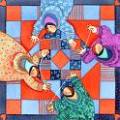
Quilting Reviews
|
All About Appliqué
All About Appliqué
Appliqué is a quilting technique which involves applying layering one fabric above another and sewing it on. The term appliqué comes from the French word appliquer, which is a French verb meaning "to put on." Even though the word comes from the French, the technique has been used in many cultures and throughout history, with the earliest examples of appliqué being found thousands of years ago. Learning the uses and how-tos of appliqué will expand the possibilities of quilting enormously for you. Appliqué is a versatile technique which is useful for design options regular quilting can't accomplish.
The first step in learning appliqué is selecting a design. Small, intricate shapes will not work well for this technique, at least not when you are first learning. Start with a simple shape for your beginning appliqué project. Something basic like a circle or heart will serve you well for your first attempt. In order to create a pattern for your appliqué design, many people choose freezer paper, because it is stiff without being too thick. Trace your design onto the freezer paper and cut it out and then you can easily trace your appliqué onto the fabric you've selected cotton is a good choice). Next, carefully cut the appliqué design out, leaving 1/8th inches all around.
In order to stabilize the appliqué, you can either glue the freezer paper to the fabric design, or pin it. Now you will have to deal with the raw edges. Since the fabrics are being layered atop one another, as opposed to being sewn in seams as with traditional quilting, it's very important to learn to finish the raw edges so they won't unravel and be unsightly. One way to do this is to take your scissors and carefully snip to the marked line and then press the seam allowance under all the way around your design. Use the tip of a Popsicle stick or a chopstick to help smooth the little edges of fabric down.
Now position the appliqué design where you want it on the base fabric and hand stitch it down. There are several possibilities for stitching your appliqué. Do you want to hide the stitches or use it as a decorative element for your appliqué? If you want to hide the stitching, blind stitch or hem stitch are good possibilities. For decorative touches, try buttonhole stitching. You can use any embroidery stitch that strikes your fancy, but with some of the more complicated stitches it's a good idea to anchor your appliqué with a hem stitch first.
The last step is to very carefully cut a small slit in the background fabric only, behind the appliqué. Be certain not to cut through the appliqué itself! Then gently reach in and remove the freezer paper. Now turn your appliqué over and press it, smoothing the edges and taking care if you've used a decorative embroidery stitch. That's it! That's how easy it is to learn to appliqué. Once you've tried your hand at appliqué, you will be glad you've added it to your quilting repertoire.
 |
 |
 |
How To Choose The Right Batting
How To Use Stencils For Quilting
How To Use Templates In Quilting
Making Sense OF Quilt Patterns
Add Life To Your Quilting With Embroidery
More Quilting Articles
... that provides warmth. The third piece is the backing. These three layers are held together with lines of stitching. These lines may be worked in a grid, in straight rows or elaborate patterns. Originally they were sewn by hand with a needle. Today some quilters still produce quilts this way, while others ...
Sewing Tips For Beginning Quilters
... double the thread. Sew with one single strand. Place the two quilt pieces that you are connecting together, with right sides facing each other. Pin them using three pins. Place one pin in each of the top two corners, and the third pin in the middle of the piece. Begin at one corner and poke the needle ...
... is also used in shadow quilting and appliqu . Organdy is a fine cotton fabric that is starched. It is used for shadow work. Organza is a gauzy fabric woven from silk or synthetic fibers. It may also be woven from silk and a synthetic blend. Organza is available in plain colors and with metallic and iridescent ...
The Best Quilting Pattern ForYour Needs
... quilt you want to make, it can be a good idea to purchase one of these, as it will have detailed directions on every aspect of the specific block. You'll find step-by-step directions that cover every aspect of the pattern for your quilt. The pattern may also give you tips and techniques you wouldn't otherwise ...

|
| Copyright © 2006-2012 Internet Marketing Tools, All Rights Reserved |